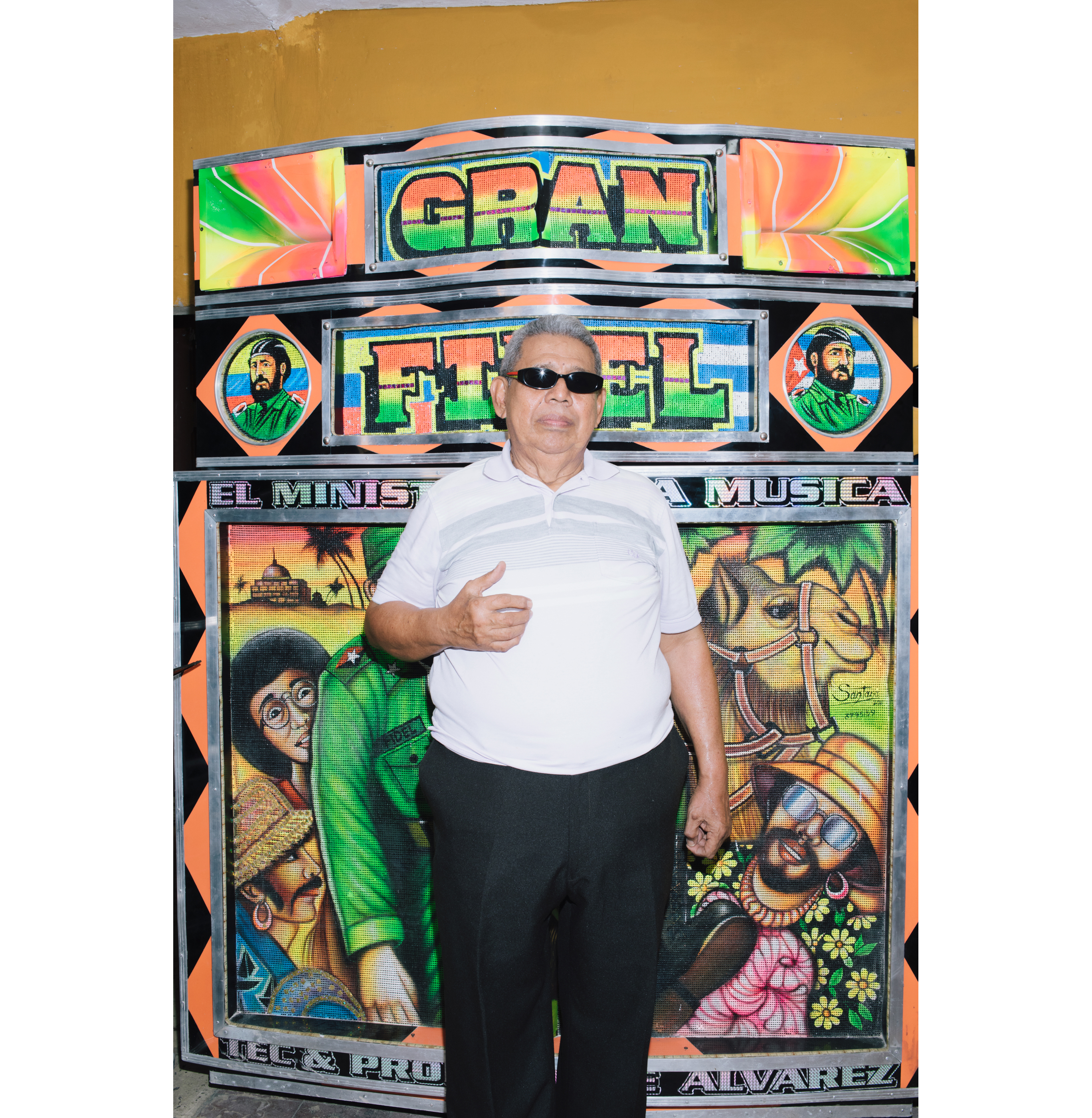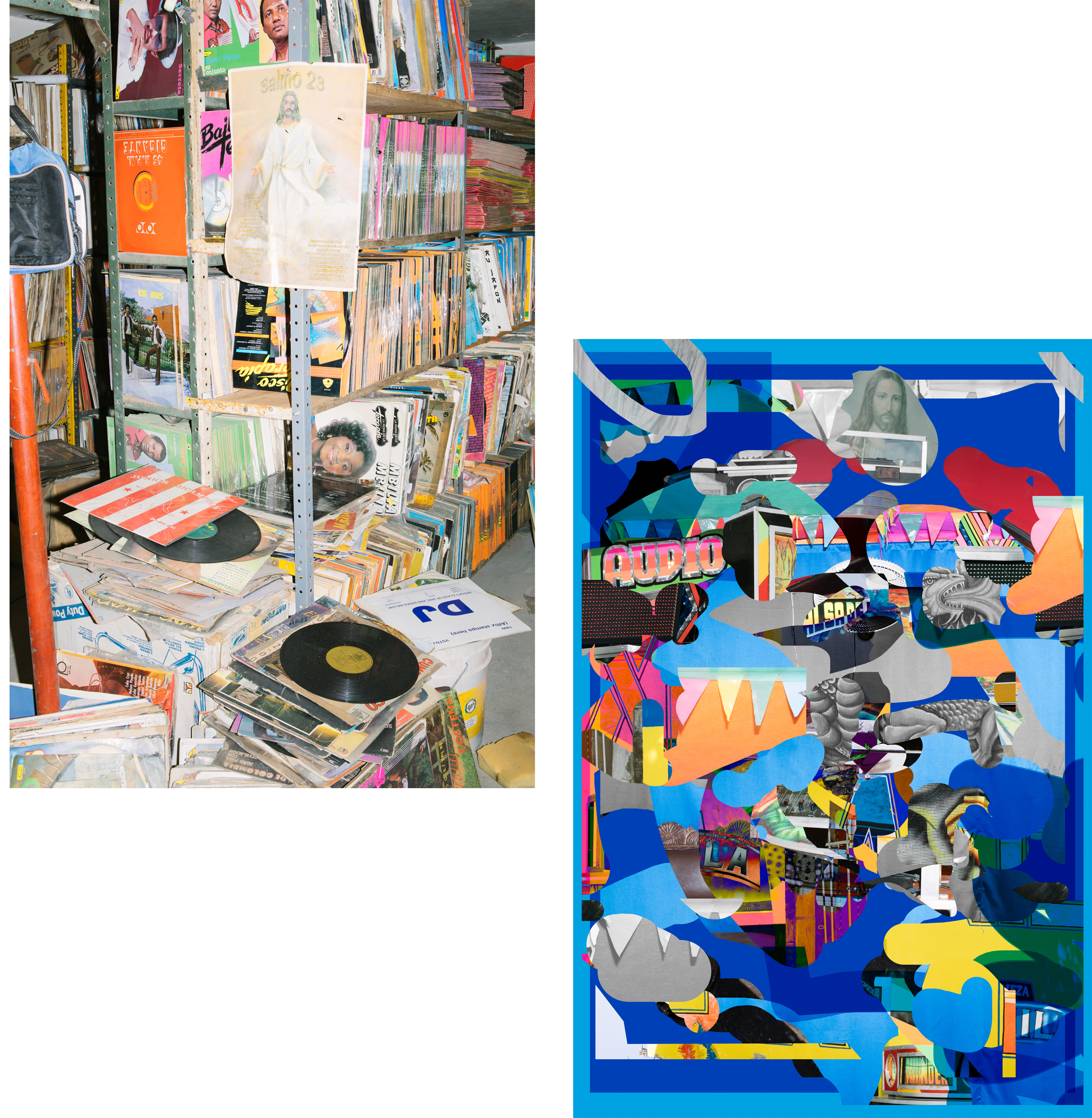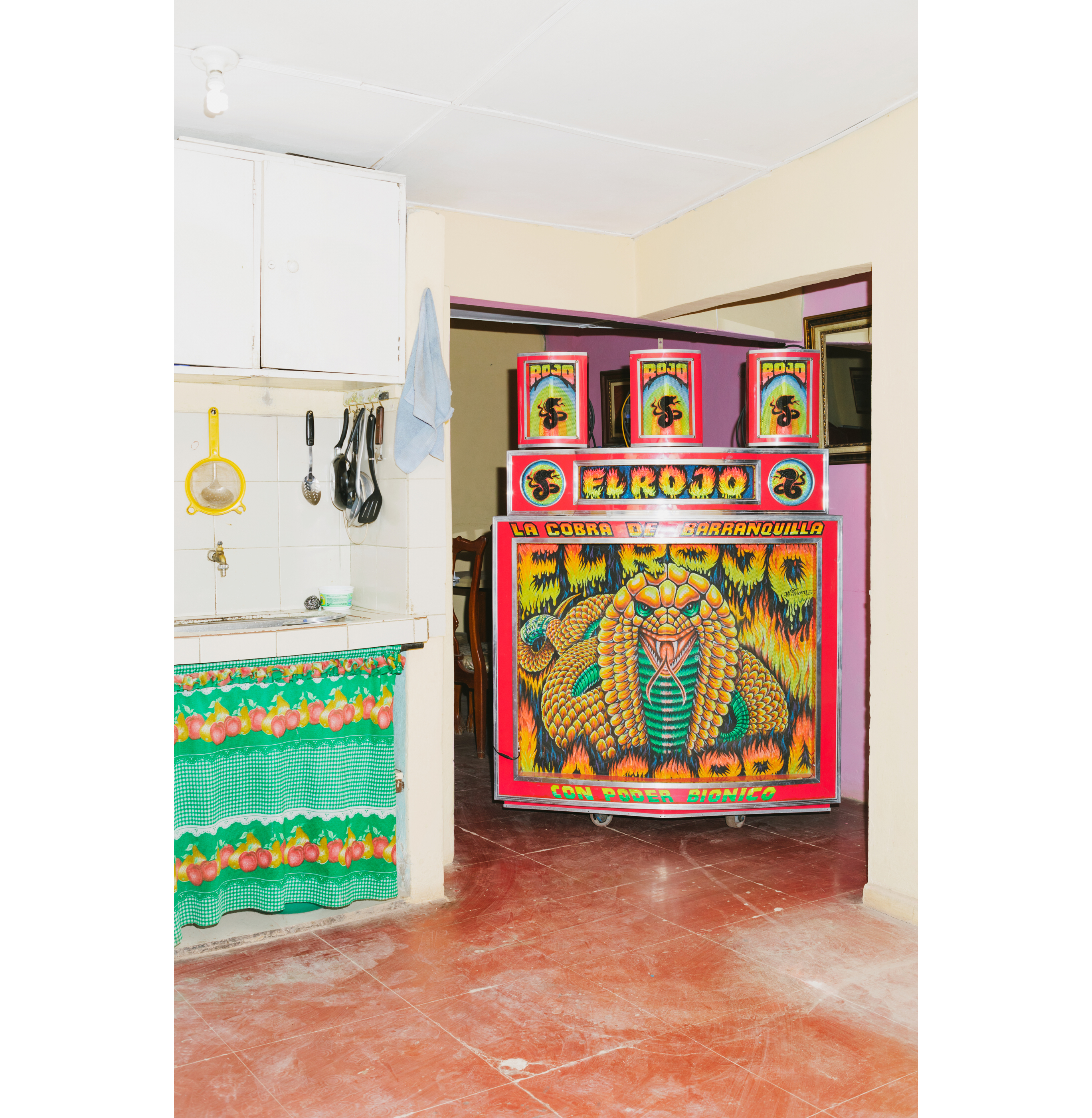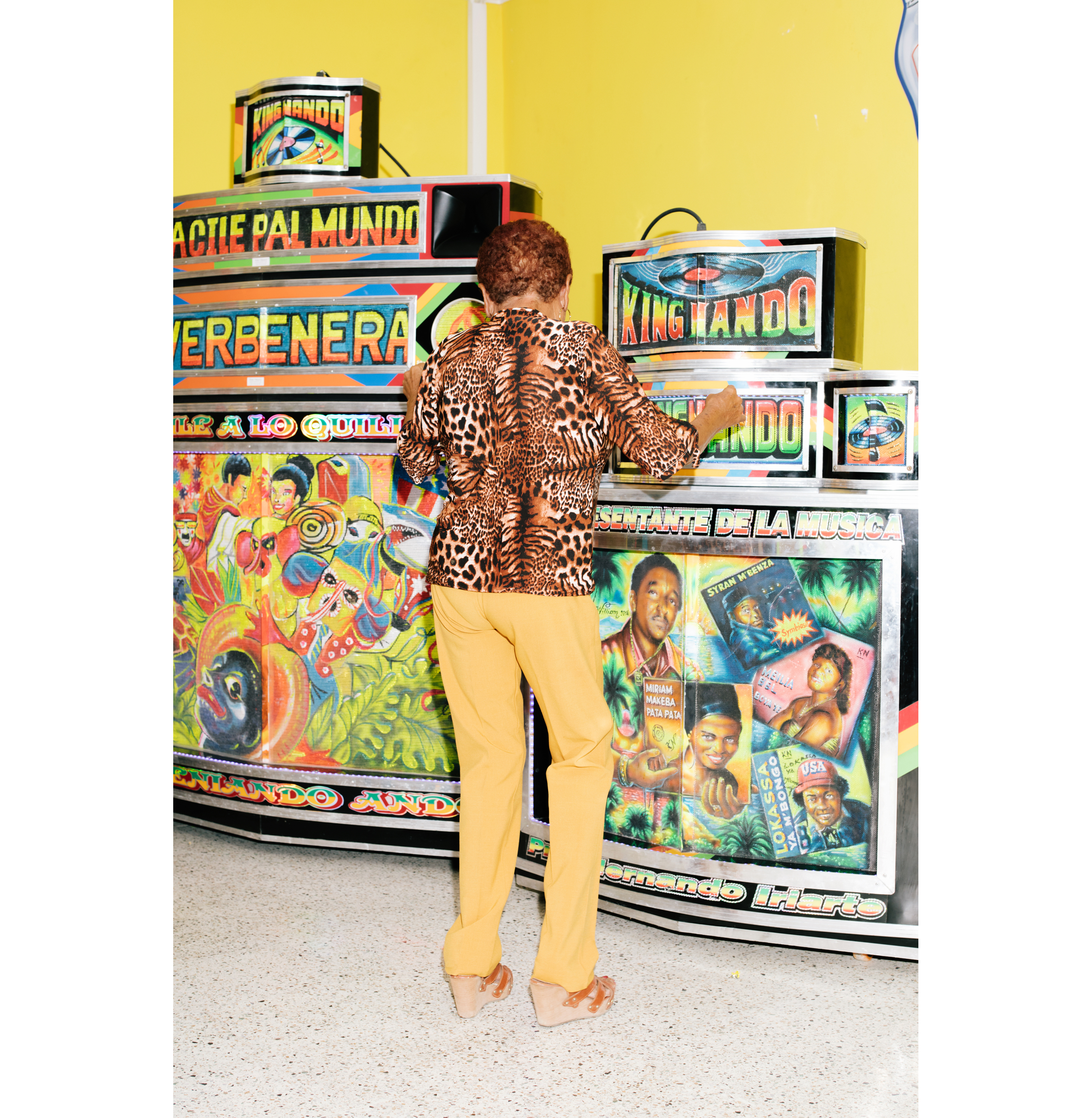This spring, VICE partnered with Fotografiska New York to present New Visions, an exhibition showcasing 14 emerging photographers from around the world who are changing the way we see. To highlight the work beyond the museum, we asked 14 of our favorite, fresh voices in culture to respond to the photos in writing.
Here, Bogotá, Colombia-based writer Christina Noriega goes deep on píco culture, inspired by the work of Austrian photographer Stefanie Moshammer. Moshammer applies the sensibility of documentary photography to staged images, allowing chance and spontaneity to be collaborators in creating partial fictions. For her series Picotera, Moshammer travelled to Barranquilla, Colombia to photograph its unique music culture. Read more from the New Visions series here, and learn how to visit the show at Fotografiska New York here.
By 11 a.m., the sound of the Beast is booming throughout the neighborhood of La Soledad in Barranquilla, Colombia. It’s the last Tuesday in February, and the last day of the seaside city’s famous annual Carnaval festivities. People are slow to rise after three sun-drenched days of spirited parades and late-night dances. Still, the Beast is hooked up and firing African soukous beats at a thunderous volume.
The Beast, an 8-foot-tall sound system, is the celebrity of its block. It’s easily recognized by the painting of X Men’s Beast character (a giant blue mutant) that emblazons its mesh grill. This kind of flashy speaker system, known as a picó, is unique to Colombia’s Caribbean Coast. They vary in size, but can be double the height of an adult person. Each is illustrated with custom neon-colored aerosol artwork. And, like the Beast, each has a name chosen by its owner, the picotero.
It’s hard to say whether picó culture first started in Barranquilla or Cartagena; both cities claim the title. But in Barranquilla, the sound systems first appeared in the 1950s. Locals told me that at the time, the top bands of the era played exclusively for affluent residents of the north part of town. Those who couldn’t afford entry, people in the barrios populares (working-class neighborhoods) of the south, developed their own music shows and dance parties in the streets. The center of the entertainment: A turntable hooked up to a flashy speaker system. Over time, the speaker set ups grew in size as the subculture solidified into something the city was known for.

It’s said that, nowadays, you can find at least one picó, if not two, on almost every block in the south. Here, they’re more than artisanal speakers; each represents the heart of its community. A common refrain in Barranquilla is that “music makes friends.” That, picoteros will tell you, is exactly what picós do: bring people together for a moment of unbridled joy and dance to counteract the stresses and troubles of long work hours and economic uncertainty.
As I wandered Barranquilla, its streets bustling with locals and tourists for Carnaval, the magnetism of the picós that dotted the streets was palpable. As soon as the sound systems turned on, a crowd of people materialized. It made no difference whether it was on a residential block, by the parades downtown, or in an old school, open-air bar known as an estadero. At one venue downtown, I waited in line for two hours to enter the fenced-in block party hosted by the club. Inside, multitudes of fans snapped photos in front of the picó of the night, the Huracan Turbo Laser.
Fernando Vilorio, the Huracan’s veteran selector, is a giant man who doubles as a bodyguard for threatened community activists and armed conflict victims. The estadero was at capacity, its doors closed despite the line outside. And inside, almost everyone was on their feet, moving to the flood of sounds coming from the Huracan’s five booming amplifiers, spread throughout the club. In the middle of it all, Vilorio was operating the turntables with easy coolness. Periodically, he would turn to the crammed vinyl crates set behind him to silently study rows of records as he searched for the perfect track to unleash another frenzy of dancing.
Vilorio’s picó obsession—as he called it—started at a young age. His father, then the local picotero of his block, introduced him to the subculture, he told me over the phone a few days after the party. Vilorio loved the music, especially the African records that arrived in the 1980s. They sounded like nothing he had ever heard before. As a kid, he would spend hours gazing at the cover artwork of his father’s extensive vinyl collection. By age 13, he started to DJ at house functions, standing on top of beer cases in order to reach the turntables.

“Picós have always been the cultural expression of the barrio, part of the idiosyncrasy of the people,” Vilorio said. “That’s what I want politicians to understand.” In recent years, the local government has begun to crackdown on verbenas (traditional block parties starring picós), in response to reports of violence and vandalism committed during the events. Part of that crackdown has been making it more difficult to acquire a permit for outdoor functions. Government officials say these measures will ensure security, but picoteros believe they’re putting these cultural traditions at risk of disappearing. Some already have. By this year, many of the south’s legendary street parties that once gathered hundreds of people during Carnival have either relocated or been cancelled.
Carlos Miranda, president of Asobaile, a local group of small-scale street party organizers, thinks that’s partially due to affordability: Costs to cover security and permits have skyrocketed (up to 4,000,000 pesos or $1,000), he said, so businesses are now largely the only ones who can afford them. But even when applicants have the resources, he’s found that parties in the south are increasingly rejected, said Miranda. Last year, only one of the 26 block parties Asobaile had planned in the south gained approval. Meanwhile, a local newspaper reported that at least 92 out of 162 requests were turned down in 2019. The Mayor’s Office did not respond to a request for comment.
Critics link these changes to the gradual privatization of Carnival. While many people still watch the Battle of the Flowers and other iconic parades from the sidewalk, private companies now charge up to 100,000 pesos ($25) for a seat in the nice part of town. Meanwhile, increasingly, several sources in the south said that the majority of parties happen in dance clubs in the north. “The ones that least benefit are the originators and pioneers of this culture,” Miranda added.
The reality is that, despite the popularity of picós, they’re often still linked to violence and drugs. Vilorio acknowledged that there’s always been a class divide on the question of picó culture. “Previously, you didn’t see verbenas in the north,” he said. “It was a stigma to see a picó there. They thought it was the most tasteless thing ever.” But he contests that there is something else at fault here: the emergence of a new generation of picoteros who pioneered a younger, grittier genre of picó deejaying— guarapo.

I met Luchin Meneo in La Soledad’s main square on Tuesday evening as the sun began to set. Sporting a crop of bleached yellow hair and a bright Hawaiian shirt, he quickly cued me to jump on his motorcycle. Moments later, we zipped away toward the street party where he was playing that night. There, we greeted the Beast—at this hour, illuminated in blue LED lights—and a dancing crowd of people gathered around it in the street. It’s a permitted, family event tonight; there’s moms, dads, uncles, aunts, grandparents, and clusters of wiry teens and children.
The decks of this picó are different. Gone are the record players and vinyl crates. Instead, Luchin’s main tools are a laptop, illustrated with the same Beast character as the picó, a drum pad, and a microphone he uses to hype the crowd. Surrounded by a group of spellbound teenagers, Luchin starts a song from the Afro-Colombian genre champeta and huddles over the drum pad to freestyle over it, layering the track with buoyant effects that sound straight out of a cartoon. While at traditional verbenas, you’d typically hear old-school salsa and soukous tracks from the 70s and 80s, guarapo sounds much different, made up of short loops of African tracks, composed in 6/8 time. The tracks are quick bursts of beats—typically no longer than one minute—overlaid with hip-hop-like lyrics and playful live percussion.

Twenty-eight-year-old Luchin Meneo, whose real name is Luis Urdaneta, is one of the pioneers of guarapo. The genre emerged in Barranquilla in the early 2010s as young DJs, such as Luchin Meneo, Edwin Producciones, and Maikol Tremendo, experimented with old school African beats on editing software. “We would take parts of African songs, the parts that we consider the despeluque [climax],” Luchin said. “We would take these instrumentals and loop them and sometimes add snippets of African acapella.” Far from the family-oriented picó events, ad-hoc guarapo concerts began attracting thousands of youth, mainly from poor neighborhoods. Sometimes these parties would turn violent, leading to deadly brawls. Critics attribute this to violent lyrics and improvised interjections used to hype the crowd, but Luchin argues that the music isn’t to blame.
“I tell people that don’t like guarapo to listen to it and to hear the lyrics we write. It’s not always bad lyrics,” Luchin said as we sat on a sidewalk a few blocks away from the thundering Beast. “I talk about real life. I even have a guarapo based on a song by Edwin Producciones that’s called ‘Advice’ and speaks to youth that are losing themselves to drugs.” Throughout the years, guarapo has gained mainstream attention. A newer crop of producers have extended the songs’ duration and toned down the lyrics.
“I don’t think music should ever be considered responsible for violence,” said Christian Gonzalez, known by his DJ persona Bclip.“We shouldn’t be creating filters for people who are creating and expressing their art.” As a DJ, producer of the group Boom Full Meke, and founder of Paria Records, Gonzalez supports musicians that belong to marginalized genres and cultures, including many impoverished youth who make guarapo. Some guarapo supporters have argued that the associated violence has less to do with the music and more to do with the systemic inequality experienced by these youth—such as lack of economic and educational opportunities, a strained home life, and even forced displacement related to the armed conflict.
Gonzalez insisted that instead of state repression, this scene needs institutional support to amplify their music and to guarantee safety in these spaces. “We live in a country where music that isn’t considered moral or politically correct isn’t supported by the city, but if there were police accompaniment, state resources provided, these events would be safer.”
Despite the divide between the old school picoteros and the new school, this is where they can agree: Picó culture needs more support. Miranda believes that UNESCO should proclaim picós part of Colombia’s Intangible Cultural Heritage, just as its carnival was in 2003. And Vilorio, as part of an advocacy group called Los Caribeñas, regularly pressures the Mayor’s Office to adopt more favorable policies toward the subculture.

As Luchin Meneo stepped away from the turntables, a younger DJ hopped up to start his set with a popular champeta track. At 9 PM, hundreds remained out on the street, eating and dancing, while more people continued to trickle in. The mood was festive. Everyone dressed in their brightest colored outfits, their shirts bedazzled with flashy sequins and threads. Kids ran after each other, hurling fists full of white cornstarch powder—one of the age old pranks people play during Carnaval.
As the song ramped up, a crowd of people, glowing in the picó’s neon blue light, formed a circle in the middle for two young girls, dressed in sneakers and hoops, to jump in. Timid at first, they eventually slid into the rhythm, their feet a blur of rapid, intricate steps. The scene continued well into the night. And for at least a moment, it seemed sure that picó culture would never die.
Sign up for our newsletter to get the best of VICE delivered to your inbox daily.
from VICE https://ift.tt/2yFR2Tw
via cheap web hosting
No comments:
Post a Comment